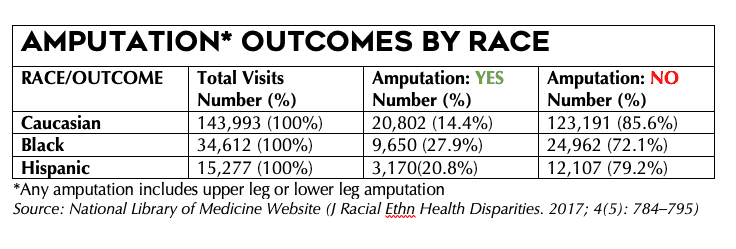People of color in the United States are roughly twice as likely to lose a limb to amputation compared to White patients. Study data has shown that the reason for the disparity is caused by a combination of a lack of access to healthcare and the severity of their condition when they receive treatment.
Since 1980, the United States has made it a priority to measure and ensure that quality healthcare is available to all citizens, as a part of the Department of Health & Human Services’ Healthy People initiative. Sadly, their data shows that there are still significant differences among racial groups in terms of healthcare access, quality, and outcomes. One of the biggest disparities is the management of chronic disease, including diabetes. As a result, African-Americans and Hispanics are approximately twice as likely to be amputated than Caucasians.
PAD, CLTI & Why Amputations Are Sometimes Necessary
Peripheral artery disease (PAD) is a common circulatory disease, which commonly affects people with Type 2 diabetes. It affects roughly 7% of people over the age of 40 in the United States. PAD is the medical term for when your arteries become clogged with fat and cholesterol, especially in your extremities, such as your arms and legs. If PAD goes untreated and is allowed to get worse, it blocks healthy blood flow (ischemia) to your limbs, resulting in things like ulcers that refuse to heal, gangrene, and other conditions that can lead to amputation.
When PAD becomes severe, it can become necessary to use surgery to help blood flow to the limbs (revascularization) or to amputate. Because of the jeopardy to the health of the limb, these situations are called Critical Limb-Threatening Ischemia or (CLTI).
Race & Amputation
Studies have shown that Black and Hispanic patients are at increased risk of poor limb outcomes, such as amputation, compared to White patients with a similar stage of PAD or CLTI.

Symptoms to Watch Out For
The Washington Vascular Specialists list the following symptoms of limb ischemia. Keeping these in mind for yourself and your loved ones can be the key to seeking timely care and avoiding amputation:
- Feeling pins and needles in the affected limb.
- Claudication, or feeling pain in the affected limb during movement or rest.
- Shinier, paler skin on the affected limb compared to the rest of the body.
- Paralysis in the affected limb.
- Cooler skin temperature on the affected limb.
- Sores and skin infections that will not heal on the affected limb.
- Having thick toenails on the affected limb.
Can Amputation Be Malpractice?
In various situations, amputation in extreme cases of CLTI is a life-saving measure. However, in other cases, medical personnel do not adhere to the medical best practices regarding the signs, symptoms, and treatment of PAD and CLTI, leading to an amputation that should have been avoided. With the help of a medical malpractice firm, you can determine if an amputation was the result of medical error and the amount that you will need to meet the various costs for medical care, mobility, emotional support, and occupational challenges you or your loved one will face. There are strict deadlines for pursuing damages due to an avoidable amputation, so it is important to act immediately, even if you are not sure whether medical malpractice occurred. The legal professionals at Brown & Barron can help you determine if your situation in Maryland or Washington D.C. is a case of medical malpractice and the next steps to moving forward. For a free no-obligation consultation, contact us online or call: 410-346-0206.


